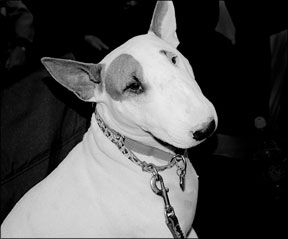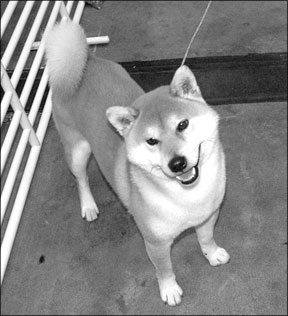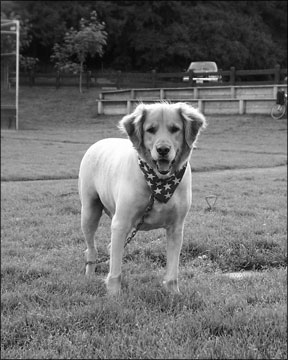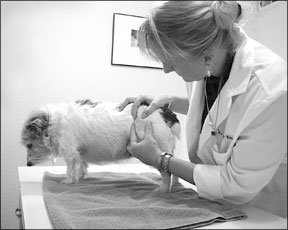The primary function of the dog’s hair is as a protective and insulating coating.
But if the eyes are the gateway or the window to the soul, the skin and hair are both gateway and window to the embodiment of an animal’s inner health and well-being. Shiny hair, that is, a hair coat that exudes a healthy and lustrous sheen, is an indicator of overall health of the animal. In contrast, a dull coat that lacks luster is an indicator that the animal isn’t as healthy as she could be.
One of the reasons people like to have pets around is that they are “furry,” and furry is fun to touch. Having a healthy coat promotes increased contact between a dog and its owner, with frequent contact ultimately strengthening the human-animal bond. Some caretakers are very sensitive to the feel and beauty of their dogs and to the “social status” that comes from owning a dog with a beautiful and/or unusual haircoat.

Changes in the texture or appearance of a dog’s coat are an indicator of something going amiss within, but haircoat changes are not specific for any one disease or condition. Dull or brittle hair can be caused by a dietary imbalance, or it may be due to diseases of digestive, hepatic, renal, thyroidal, immune, or parasitic origin. Alterations of hair typically appear rather late in the course of the disease, as hair growth is rather slow; it usually takes at least four weeks of disease progress before changes are noticeable in the hair. And it typically takes four or more weeks before a dietary supplement will have any positive effects on the quality of the hair.
The shine attributed to a healthy dog’s coat is largely due to a complex group of fats secreted through glands in the skin known as sebaceous glands, which function as a natural dispenser of hair conditioners.
Skin and hair basics
A dog’s skin and haircoat form a barrier to protect the body of the dog from infections, parasites, and the elements.
Animal hairs are classified into three basic types: a) “primary” or “guard” hairs that form the outer coat of an animal and provide protection from sunlight, moisture; b) “secondary” hairs (also known as fur or wool hairs, or the undercoat) that form the inner coat of an animal and provide insulation; and c) tactile hairs (whiskers) that provide sensory functions. Other types of hairs found on animals include tail and mane hair (in the horse, for example) and sensory hairs located in the inner ear (hairs that detect motion).
All adult dogs have longer primary hairs and shorter secondary hairs, but the ratio of each type of hair differs by age and especially breed. Some breeds have almost no undercoat and relatively short and thin primary hair. These “single coated” dogs include Boxers, Dalmatians, and Greyhounds. Yorkshire Terriers, too, don’t have much of an undercoat, but their primary coat is long and silky.
So-called “double-coated” breeds have significant undercoats and dense primary coats. The Labrador has a short but very dense coat of coarse primary hairs, and a thick undercoat of softer, insulating secondary hairs. The Bearded Collie has a soft, close undercoat and a shaggy outer coat.
Puppies are born with short, soft secondary hairs only. Sometimes the puppy’s coat color is similar to the adult’s; in other instances, the coat darkens or spots as the puppy matures. Dalmatian puppies are born with a pure white coat that develops black spots as the puppy grows.
Dogs of different breeds (and individuals within those breeds) display different rates of coat development. Most dogs have full, adult coats by six to eight months of age. The dog’s environment (length of day, average temperature), diet, and hormone levels can influence his coat development.
Dog hair is made of a hard substance called keratin, an insoluble protein that contains high amounts of sulfur (as the amino acid cystine) and lesser amounts of the amino acids tyrosine and leucine. Hair emerges from follicles, just below the outermost layer of skin. In humans, each hair grows from a single follicle. Dogs have single and compound hair follicles; a central follicle that produces the primary hair or guard hair may have two or more lateral follicles that produce 5 to 25 secondary hairs each.
Dog hair varies considerably in its coarseness or thickness actually a function of the hair’s diameter. Fine dog hairs measure about 75 microns; coarser hair may exceed 200 microns. Healthy hair relies on the balance of the diet: proteins (and especially the sulfur-rich amino acids such as cystine, as well as tyrosine and methionine), essential fatty acids, copper, and B vitamins. Up to 30 percent of the daily protein requirement of an adult dog can be used for the renewal of the skin and the hair.
Hormonal factors can also interfere with proper hair growth: thyroid and growth hormone stimulate the activity of the hair follicles, whereas corticoids and sexual hormones slow it down. When prolactin (a hormone produced by lactating females) levels stay high in the blood, the coat looks like the summer one, rather thin and sparse.
Everybody sheds
Breeds and individuals within every breed shed and regrow hair at varying rates. Dogs who live indoors, with little exposure to natural light or cold temperatures, tend to shed in a more or less continuous fashion.
In contrast, dogs who live outside, exposed to natural light and cold temperatures, are more likely to shed for several weeks in the spring and fall. In the fall, their short, light coats shed as they grow a thick, warm undercoat and long, weather-resistant guard hairs to prepare them for winter. In the spring, the winter coat is shed to make way for new, shorter, and lighter coats. The hair coat changes in appearance and texture but the absolute numbers of hair follicles and hair do not.
Contrary to popular belief, there is no such thing as a dog who does not shed; there are only dogs who shed a lot less. Each hair shaft produced by a hair follicle will eventually die and become dislodged from the skin (shed) and be replaced by a new hair shaft produced by that hair follicle. However, there are some breeds whose hair grows for a much longer period before it dies and is shed. There are several phases in the activity of a hair follicle. In the first, called the “anagen” or growing phase, the hair is produced by the follicle.

The “catagen” phase is a short interlude between the growth and the resting (“telogen”) phase. In the telogen phase, the hair follicle is basically dormant. The growth of the new hair pushes the old hair out of the skin. Even though spring and fall bring on prolific hair growth, the dog’s hair follicles are not all in the same phase at the same time, so thankfully he never becomes totally bald!
In humans, the hair follicles on our heads spend most of the time growing (anagen phase). This phase can last years, depending on the ultimate length of your hair (as determined by your genes). In contrast, the resting phase for each follicle is generally only weeks. Poodles have a predominantly anagen cycle like ours; their hair grows for so long, that it needs cutting (perhaps several times) before it falls out.
Most dogs, though, have a telogen (resting) predominant cycle. In these dogs the anagen phase is short, only long enough to achieve the genetically desired length of coat ¨C anywhere from one month to a year or more. The hair then cycles into the telogen phase and remains there for a prolonged period of time. This hair is tightly bound within the follicle and will not readily fall out or be pulled out. In the Nordic breeds, it is thought that the telogen phase may last for years.
Finally, any stress such as anesthesia, disease, pregnancy, or administration of certain drugs is likely to put most of the follicles into a resting phase. About two to three months after the stressful event, when the follicles start to be active again, abnormal shedding will often be observed.

Natural color
A dog’s coat color is determined by his genes. That said, a variety of environmental factors can somewhat alter the color of his hair. Specific nutrients may be involved in hair color. Cystine, methionine, arginine, tyrosine, and phenylalanine deficiencies are reported to induce hair discoloration. Protein malnutrition induces disturbances in hair growth and quality.
A 2004 study by the American Society for Nutritional Sciences reported that trace-element deficiencies or imbalances also affect hair quality. Suboptimal zinc levels, it said, induce graying of hair, and copper deficiency causes fading of brown- or black-pigmented hair. Other trace elements such as iron and iodine can also affect hair color, as well as vitamins A, B-2, and B-6, pantothenic, folic, and nicotinic acids, and biotin.
Too much exposure to sunlight can make the hair brittle and cause a black coat to redden or turn brown. After a dog has been clipped, the color of its hair is noticeably lighter, and scars often leave a mark of hair that remains white throughout the rest of the dog’s life.
In aged dogs, hair color tends to fade. As a dog ages, his hair turns gray, especially on the head, beginning with the muzzle.
Hair loss in dogs
The common causes of hair loss in dogs, along with the basics of the appropriate natural remedies, are summarized below. Most are primarily problems of the skin and were more thoroughly covered in “Skin Secrets,” Whole Dog Journal November 2005.
• Flea-associated dermatitis
A dog with flea infestation typically has a brittle, broken hair coat, especially in the area just in front of the tail head where fleas prefer to reside.
Natural flea control always involves a multi-pronged approach. It’s been estimated that less than 10 percent of a given population of fleas are found on the resident dog at any given time. Killing the fleas on the dog, then, is actually a small part of the job!
The bigger task involves removing larvae and pupae from your dog’s home and eliminating places where the flea eggs can develop. Accomplishing this requires what’s called an “integrated pest management” program. In my experience, herbal anti-flea remedies are not tremendously effective as a first line of defense. For more on fleas, see “Eliminate Fleas Without Poisons,” March 2002.
• Canine atopy
This is an allergic itching syndrome along with subsequent loss of hair that is thought to be genetic in origin. Natural care will involve enhancing the immune system with herbs, supplements, and perhaps acupuncture. Natural anti-itch and antianxiety herbal remedies, acupuncture, or homeopathic therapy may also be helpful.

• Pyotraumatic dermatitis (hot spots)
Hot spots involve intense itching in one or two isolated area of the trunk or limbs of the body. The involved areas may become inflamed and raw within a matter of hours. Stress may be a factor in its onset.
Natural remedies for hot spots, in my experience, have worked far better than the conventional medical treatments. I like to brew up a tea of calendula and use it topically on the affected areas. Herbal immune system enhancers such as echinacea are an important part of my recommended protocol, and in severe cases acupuncture or homeopathic remedies may be helpful.
I’ve also found that many of the hot spots are brought on by a segmental nerve-caused itch, the result of a misaligned spine or limb joint; chiropractic adjustments seem to be most helpful for these.
• Mange
Demodectic mange is caused when a parasite, Demodex canis, which lives a natural life in the hair and oil glands of the skin of most healthy dogs, starts multiplying rapidly. This tends to occur in young animals with an unhealthy immune system. It may have a genetic basis, as it tends to run in certain lines of dogs and seems to be more common in certain breeds. It doesn’t cause itching, but the involved areas are subject to secondary bacterial infection.
My thrust with natural remedies is to rebalance the immune system with herbs such as echinacea, antioxidants, and sometimes acupuncture.
Sarcoptic mange is due to a transmissible parasite that burrows through the layers of the skin causing intense itching. It passes from pet to pet through contact, and can pass to humans, too.
Sarcoptic mange, in my eyes, is primarily a disease of the immune system. I treat it with herbs such as echinacea, antioxidants, and possibly acupuncture to help balance the immune system. Topical herbal remedies can help decrease infections and minimize parasite numbers. Topical and internal anti-itch remedies may also help.
• Ringworm
Ringworm is a fungal disease that creates a round or oval non-itchy area of hair loss. Hair is lost because the fungus weakens the hair shaft and causes it to break off.
Some cases of ringworm respond to herbal topical remedies such as goldenseal, calendula, myrrh, or thuja along with internal herbs such as echinacea, cleavers, and yellow dock. Iodine preparations, used topically, may also be helpful, and once again, energizing the immune system may be beneficial.
• Stress-induced dermatitis
This “disease” typically affects “Nervous Nellies” who cannot sit still. Affected dogs simply chew on themselves if they can’t find anything else interesting to do.
The primary cure for this condition is to provide plenty of exercise and plenty of challenging tasks for the dog to do. Training games, food-dispensing toys, and frequent changes of activity can help distract and engage the dog in more healthful patterns. Flower essences may also be helpful when they are matched to the personality of the dog.
Many of these dogs have an itch caused by a misaligned vertebrae and they chew or dig at it. Chiropractic adjustments have helped a lot of these animals.
• Food allergies
While food allergies may be the cause of some itchy dogs, research would indicate that skin cases are not often related to food allergies. In dogs, the primary signs of food allergies are most often related to gastrointestinal upset. When we get the gut back into balance, the animal no longer has a problem with food allergies of any kind. (For more on this, see “Gut Feelings,” March 2005.)
• Miscellaneous conditions
Pyoderma, excessive numbers of bacteria in the hair follicle, may cause circular areas of alopecia or generalized excessive shedding. Natural treatment for pyoderma includes the use of topical and oral herbal remedies with antibiotic activity. Some breeds, like the Chow-Chow, may have an arrest in the hair growth after clipping. This resolves spontaneously after several months of a lack of hair regrowth.
Many diseases are associated with hair cycle abnormalities, including endocrine diseases such as hypothyroidism and Cushing’s syndrome; hereditary alopecia and hypotrichosis (the presence of less than normal amounts of hair); and familial zinc-responsive dermatopathy.
Holistic approach
From the veritable plethora of potential causes for poor hair growth listed in this article, it should be obvious that there will be many different approaches to finding a solution and each individual dog will require its own specific remedies.
My approach includes an individual-specific protocol that usually includes:
• Reenergizing the immune system. I commonly recommend herbal remedies, antioxidants, omega-3 fatty acids.
• Attention to diet, including making sure that all nutrients, especially vitamins and minerals, are balanced. Supplements include omega-3 and essential fatty acids.
Many holistic practitioners have found that simply adding raw meat to the diet (beginning with about 1 teaspoonful per 20 pounds of the dog’s body weight and gradually building up to about a quarter to a third of the total diet) will be the best skin and hair coat “medicine” money can buy.
• Chiropractic adjustments often worked when I’ve been treating skin conditions, so I think they should always be used.
• Specific natural remedies when indicated for instance, flower essences and/or calming herbs to calm the nervous beast, topical herbals for itch control and faster healing, and acupuncture or homeopathy when indicated.





